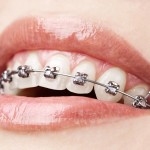
Fixed orthodontic appliances are bonded to teeth using a composite material. Priming agents are used to increase the strength of the bond. However a number of in-vitro studies have suggested that bond strengths are similar with or without the primer.
The aim of this trial was to determine whether a primer is required as part of the orthodontic bracket bonding process.
Methods
Patients that had no previous orthodontic treatment and requiring single or two-arch fixed appliance therapy were considered. Patients were randomised to test or control arm. Patients in the control arm had their brackets bonded using a standard process. Those in the test group had an identical procedure with the exception of the application of the primer. Failure rates were assessed at 12 months.
Results
- 92 patients (53 females and 39 males) were randomised. 2 patients withdrew following relocation.
- The average age was 15.6 years.
- The overall failure rate was 13.5% ( 218/1615).
- Failure rates are shown in the table
| With primer | Without Primer | |
| Failure rate | 11.1% | 15.8% |
| Failure rate (excluding 1st molars) | 10.3% | 14.4% |
- Bonding without primer was shown statistically to be non-inferior to bonding with primer odds ratio 0.95-2.25 (P = 0.08).
- Mean difference in bond-up time per bracket was 0.068 minutes (4 seconds), which was not statistically significant (P = 0.402).
- There was a statistically significant difference in the Adhesive Remnant Index – ARI 0 with primer 49.4 per cent, no primer 76.5 per cent, (P < 0.0001).
Conclusions
The authors concluded
When bonding with APC™II Victory Series™ brackets without primer was shown statistically to be non-inferior to bonding with primer (P =0.08). There was no significant difference in bond-up times. Bond failure was more likely to happen at the composite-enamel interface when bonded without a primer.
Commentary
This well conducted study suggests that there is no statistical difference in failure rates with or without primer. However there were more failures in the no primer group and the authors recommend caution in interpreting the findings as there was only one operator using one specific bracket system. The results of this study are presented at 1 year on fixed banded orthodontic treatment typically lasts longer than this so it would also be interesting to know whether the failure rates continue to show no statistical difference to when the appliance requires debonding. As the authors suggest we need additional studies with multiple operators before these findings can be generalised.
Links
Nandhra SS, Littlewood SJ, Houghton N, Luther F, Prabhu J, Munyombwe T, Wood SR. Do we need primer for orthodontic bonding? A randomized controlled trial. Eur J Orthod. 2014 Sep 18. pii: cju024. [Epub ahead of print] PubMed PMID: 25234405.
Mandall NA, Hickman J, Macfarlane TV, Mattick RCR, Millett DT, Worthington HV. Adhesives for fixed orthodontic brackets. Cochrane Database of Systematic Reviews 2003, Issue 2. Art. No.: CD002282. DOI: 10.1002/14651858.CD002282.

Don’t miss – Orthodontic bonding: no need for primer? http://t.co/ojJMF6apAP
Very interesting findings. I guest primer is not essential for bonding.
As the authors of the study noted there was only a single operator so it would be good to see larger studies involving multiple operators to get a definitive answer
[…] Dental Elf – 22nd Jan 2015 – Orthodontic bonding: no need for primer? […]
[…] Dental Elf 22nd Jan 2015 – Orthodontic bonding: no need for primer? […]